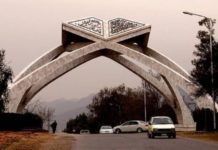Disclaimer: The Eqbal Ahmad Centre for Public Education (EACPE) encourages critical and independent thinking and believes in a free expression of one’s opinion. However, the views expressed in contributed articles are solely those of their respective authors and do not necessarily reflect the position or policy of the EACPE.
One ill-conceived and ill- fated political manoeuvre in 1947 split apart the Indian sub continent into two countries, resulting in a huge exodus of people and horrific genocides. These two unfortunate countries, India and Pakistan, continue to pay for this historical blunder to date. Let’s for now, put aside assigning responsibilities for this humungous historical blunder. Whether it was the Machiavellian British, or the greedy-for-power politicians or the communal leaders is another story. The unfortunate fact remains that this brutal tearing apart of a human, cultural and geographical fabric gave birth to two national and political entities who came to brick bat over a dividing wall raised through an erstwhile common courtyard. Both the neighbouring countries have had seventy one years to re-think and re-orient their perceptions and policies towards each other since then and failed; failed to move on; failed to seize the advantages of a common heritage and proximity and translate it into political and economic strength.
As the Indo-Pak relations stand today, both countries are paying a huge human and economic cost for their on-going political strife, whereas the majority of their populations struggle to keep enough food in their bellies and clothes on their backs.
Pay close attention to some of these basic indicators of well being and development for both the countries.
India ranks at 139 and Pakistan at 147 positions out of 164 in the list of per capita GDP (IMF list, 2017).
Pakistan’s census for 2017 shows an alarming decline in the literacy rate from 60 percent to 58 percent and with a global ranking of 135. The literacy rate in India is 72.1 percent, ranking at 92 globally.
Life expectancy in India is 68.3 years and in Pakistan 66.63 years against a global average of 72 years.
Pakistan ranks 93/111 on the quality of life index, (Economic Intelligence Unit), India 73/111.
Together, India and Pakistan could be a force to reckon with in the sub continent.
The above figures bring out the huge challenges India and Pakistan face to meet the basic needs of their people: sustainable income, education, health and security. Instead, both the countries have squandered ill-afforded resources on developing nuclear weapons and cross border strife at the cost of looking to fundamental needs of their citizens. The huge resources used to equip and maintain armies in Kashmir could be diverted to constructive developmental areas. How do they justify bragging about joining the nuclear club when a section of their population does not have access to potable water and electricity?
India and Pakistan are one divided-into-two countries with hugely similar cultures, sensibilities, languages and cuisines. It would be so effortless to trade and share human power across the borders; to learn the best methods from each other in various fields; to share intellectual and artistic pursuits. Together, India and Pakistan could be a force to reckon with in the sub continent. It is time for both countries to correct the fault lines that came up in 1947, move on and redefine their relationship in interest of mutual development and wellbeing.
About the Author:

Dr Ranjit Powar is a psychologist who has served with the Punjab Civil Services and earlier as a lecturer with the Punjabi University, Patiala. Besides writing as a freelancer, she works with NGOs for imparting employability training to high school students.








